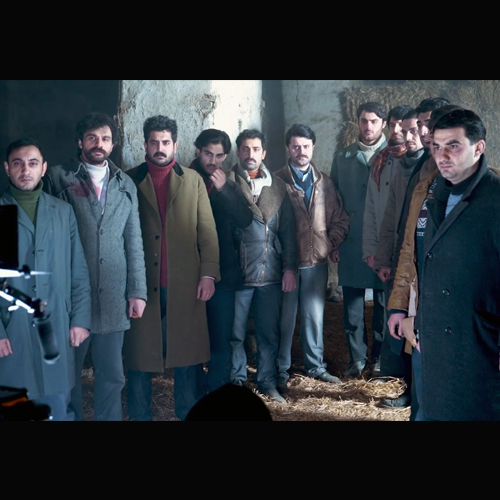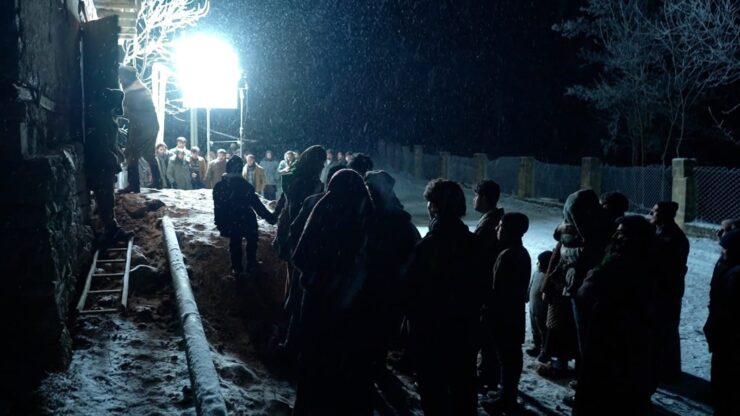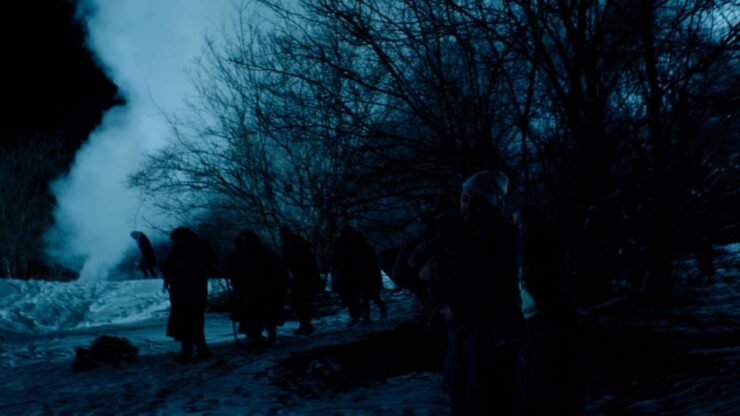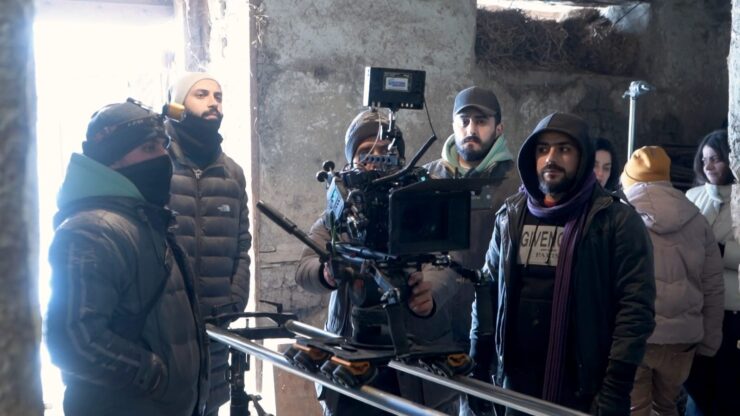13

The Khojaly tragedy should never transform to a statistic, formal history that we will remember. One of the significant ways to keep the tragedy of Khojaly alive in our memory is the professional and highly artistic expression of these events, its eyewitnesses and victims in literature and works of art.
Unfortunately, national Azerbaijani cinema has not fulfilled its moral duty in front of the Khojaly tragedy in broad terms. This tragedy has not yet been made into a feature film. Because in all cases, a full-length feature film has a deeper impact on the feelings of the audience living any part the world. Of course, it belongs to an artistic quality work…
However, so far, short feature films and documentaries have been produced on the exact topic, and those audiovisual works have been screened abroad on various platforms. Among them, both are there. Either low or powerful ones in terms of artistic-aesthetic approach to the subject.
In my mind, the feature-documentary film “13”, premiered at the Nizami Cinema Center on February 24, is one of the quality works on this topic. The aforementioned film, which was made with the financial support of the Agency of State Support to NGOs, is an artistic solution of the fate of 13 men who were selected among a group of civilians who were besieged and taken hostage in the direction of Dahraz village. Since there is no information about these 13 people mentioned in the film, they are considered missing ones.

The head and screenwriter of the “13” film project is Mubariz Asgarov, the chairman of the “Objective” Support for Promotion of National Values Public Union, TV journalist. The content of the script, the approach to the topic, crucial documentary materials screened on the screen prove that the authors have detailed information about this episode of the Khojaly genocide, and thoroughly researched the case. This is not accidental. Because Mubariz Asgarov is an experienced journalist of many years including the author of the documentary “Temple of Torture – Shusha Prison” and the short feature film “Geography Teacher” both covering Karabakh events.
Director Elchin Elkhanli tries to find as interesting form and intonation as possible in the film, rejects the monotonous, television aesthetic style and form. He establishes the connection between artistic images and documentary facts in a dramaturgical order, creates an emotional bond between the real witnesses and the fictional characters who portray them and 13 people. It conveys the event’s severe, intense rhythm through expressive and dynamic editing. The main story line is chosen successfully and this is also used as a trick in the transition from episode to episode. Armenian soldiers demand jewelry and passports from the residents of Khojaly, whom they took hostage. The close-up of passports thrown into an empty bucket is justified by the course of events. As the men chosen from among the hostages are taken away by the Armenian military, the real photo of each of them in their passport and the picture of the actors portraying them are shown throughout the film. Thus, camera emphasis on the passport photos of each of the 13 people, their separation from families` scenes, pauses form a single plot line, maintaining the continuity of the storytelling tempo.

The crucial aspect of “13” is that the historical facts are loaded with emotional depth. The primary mission of art is manifested exactly on this matter: to give an artistic form corresponding to historical facts, to transform them into a feeling, concussion. The identity of our missing compatriots is narrated with important biographical details via both artistic scenes and their relatives as well as acquaintances. Eyewitnesses describe what they saw against the background of fictionalized images and in winter clothing. This approach does not let the audience to detach from the impact of the story and keeps them under emotional pressure. We hold our breath until the end, when we see liberated Khojaly from occupation on the screen.
Cool colors and color palette, location scouting, small details – a doll on the snow, shots of a blizzard from a small window create an atmosphere of tragedy. Although gunshots were heard, it is unclear whether the selected people were killed or not. Interviewer in the film, Eldar Samadov, the deputy head of the working group of the State Commission on Captives and Missing Citizens, mentions that according to the information provided by the population, the team leader who took these people was an officer named Samvel from the Chanagchi village: “During the subsequent negotiations, Armen Isagulov, who worked in Khankendi as the head of the Internal Affairs Department, sent them to Armenia. Their further fate is unknown.”

Elchin Elkhanli managed to work well with actors from an overall perspective. However, one gets the impression that the main concern of the actors is not to forget the director’s task in the scene of clambering into indoor, ramshackle building. Thus, because of their focus on this, unnaturalness could be perceived in that episode. Or in some shots (especially close-ups) the acting and the words seem a bit exaggerated. However, minor defects do not affect the overall quality of the film.
One of the most challenging issues to overcome in multi-character scenes is to find the individual attitude and reaction of each character to the same situation. In this regard, there were several actors’ acting engraved in my mind, particularly. One of them was played by young actress Esmiralda Abdullayeva. Esmiralda Abdullayeva portrays Kamila, one of the 13 people in the film, who is Aladdin Pashayev’s sister. After taking her brother away, Kamila’s became speechless. She is not able to speak until today. Esmiralda Abdullayeva dives into the depth of the situation and convinces of her fear and desperateness.
Another missing person, Vugar Huseynov’s sister, Zarafshan, went out of her mind due to mental stress who died recently in the hospital where she was being treated. Sabina Mammadova, who plays her, is with her complex psychological situation in pain, without giving any kind of hysteria. I definitely should emphasize the performances of Aysel Usubova, who played Rovshan Hasanov’s sister, Khuraman, and Kamil Nazim, in the role of Tofig Zeynalov, whose two brothers were shot in the forest.
One of the hurtful parts was the memories of photographer Reza Deghati about the incident. After the exact tragedy, one old man drew the attention of Degati, who was on his way to Aghdam. The old man, whose name is Pirgulu, sat on a stone for four days, holding a photo, asking only about his son Azad. So this old man cries his eyes out. Degati takes a photo of him and demonstrates it at various exhibitions around the world. According to the photographer, this photo does not leave the viewer indifferent anywhere in the globe. Indeed, the portrait of Pirgulu Jabbarov is not just a picture of a person, but a photo of SADNESS. The words of Azad Jabbarov’s son Fuad in the film are shaking: “I imagine my father from photographs and people’s conversations. I would really like to see my father after 30 years even for an hour, for a moment.”

Ulfat Aliyev, who left his studies at the Azerbaijan Pedagogical Institute of Russian Language and Literature named after Akhundov unfinished and returned to Karabakh, was the only child of his mother. The exact mother who loses her only child sinks into a deep depression, pulls away from life for 17 years, does not speak to anyone and dies. His mother sees Ulfat in dream only once when he says, “Mom, I got tired.”
Sahin Mamishov was one of the last to leave Khojaly, and his wife was also martyred during the events. Another missing person of these 13 was Sayavush Usubov. His brother Rizvan cannot recover after this incident and commits suicide after his release. Brothers Zakir, Elshad and Elyar Usubov are among the 13 missing people too. Usubali Garayev`s 2 children survived. Elshan Baghirov`s name is among 13 missing person.
Eldar Samadov mentioned at the premiere that after the liberation of Azerbaijani lands from occupation, the State Commission receives new applications regarding missing people: “After such applications, the number of missing people during the Khojaly genocide has exceeded 200. On February 23, the 13th mass grave was discovered in the liberated territories. We will work until we discover the last missing person. The fate of all of them will be clarified.”

It is beneficial to mention the name of producer, Khayyam Abdulla and the director of photography Ahmed Barasov. In a nutshell, I must also emphasize that among visual works made with the financial support of the Agency of State Support to NGOs, some works got a bad mark which I have written several critical articles on them. However, the reforms carried out in the NGO sector in recent years, in a good way, the strengthening of control led to the production of quality films like “13”.
Sevda Sultanova
